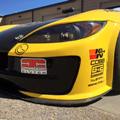After some searching, I'm not sure anybody is actually running the large 6-piston/4-piston Wilwood option on an 818 R or S yet.
The FFR red car pictures show the 4-piston.
I had 13", 6-piston fronts on my Roadster for some autox and two track days and I loved them. They were easy to modulate with an aftermarket manual master cylinder, and they had no problem at Auto Club Speedway.
My priorities here are:
1. reliability
2. durability
3. performance
4. weight
I'm perfectly fine accepting the additional weight of the 6-piston fronts as long as there is a tangible benefit in durability and performance. So my question is: Is there a tangible benefit in durability and/or braking performance with the big 6-piston kit over the 4-piston kit?
The pursuit of weight savings often involves compromises that amateurs like me can't afford in the long run. I think by the time the R is put on the scales it will only be a couple hundred pounds lighter than the Roadsters, so I'm leaning toward the 6-piston since I liked them so much on my Roadster.
- Home
- Latest Posts!
- Forums
- Blogs
- Vendors
- Forms
-
Links

- Welcomes and Introductions
- Roadster
- Type 65 Coupe
- 33 Hot Rod
- GTM Supercar
- 818
- Challenge Series
- 289 USRCC
- Coyote R&D
- Ask a Factory Five Tech
- Tech Updates
- General Discussions
- Off Topic Discussions
- Eastern Region
- Central Region
- Mountain Region
- Pacific Region
- Canadian Discussions
- Want to buy
- For Sale
- Pay it forward
-
Gallery

- Wiki-Build-Tech



 Thanks:
Thanks:  Likes:
Likes: 

 Reply With Quote
Reply With Quote








